
From left: Haas Mengoli, equipment manager at The Bear’s Club in Jupiter, Fla.; Todd Miller, Golf Safety owner and founder; and John Katterheinrich, The Bear’s Club superintendent. Photos courtesy of Golf Safety
Editor’s note: The following article was supplied by Golf Safety. All product claims, research cited and other information is directly from the company.
If you’ve ever wondered how to achieve excellence in your equipment fleet and golf course maintenance departments, here’s an easy way to attain it: Hire two managers with 41 years of experience on your property! That’s what you have at The Bear’s Club in Jupiter, Fla. Superintendent John Katterheinrich has spent 20 years maintaining this picturesque track, along with Haas Mengoli, equipment manager, who has been at the club for 21 years.
Forty-one years of combined experience is a great way to achieve excellence in your golf maintenance operation, but for the purpose of this article, we’re going to talk about how you can achieve an excellent safety record through that experience.
We at Golf Safety were lucky enough to sit down with Katterheinrich and Mengoli on a warm summer day in South Florida. The discussion focused on the multistep process they use when training their crew on how to handle gas power tools. The Bear’s Club has employed Golf Safety for the better part of 20 years to handle its safety planning, so the conversation was a familiar one.
Portable gas power tools such as string trimmers, hedge trimmers and leaf blowers may look small and harmless compared with larger equipment. However, if an operator doesn’t follow the correct safety protocols, these tools can present a significant hazard to your crew. These tools are so prevalent on the golf course because they’re so efficient. Unfortunately, if mishandled, that efficiency can lead to accidents in which these tools cause foreign objects to fall, splash or be thrown with a considerable amount of force. You can see how fast a string trimmer cuts and flings grass — now imagine how quickly it could fling a pebble in a crew member’s direction.
Katterheinrich, a 40-year GCSAA member, and Mengoli, in conjunction with Golf Safety, have developed written safety programs and standards for every task The Bear’s Club golf maintenance staff is required to do. These written policies cover things such as chemical safety, hazard communication, utility vehicle safety, and safe use of all the gas power tools on the golf course. This is where the gas power tool training process begins. These written policies cover the rules and regulations related to each job and piece of machinery on the course. Each of these written safety plans lays out all the personal protective equipment that specific equipment and jobs require, from hard hats to cut-proof chaps and everything in between.
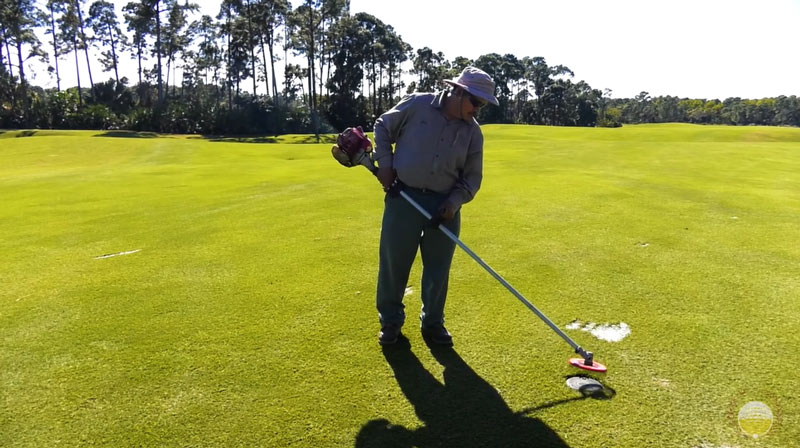
String trimmers are common on the golf course and could be dangerous if used improperly.
If you’re a golf course superintendent, you must take responsibility for the safety of your crew when using power tools. This means that every crew member using a specific tool needs thorough training on using it per the operator manual, as it happens at The Bear’s Club. You can keep track of this training using the Golf Safety training attendance documentation system. Apart from tool-specific training, essential precautions to always take when using a gas power tool are:
- Safety comes first. No deadline is ever more important than a person’s health.
- Always examine tools for damage before using them. If a tool is damaged, encourage your crew to report it immediately and not to use the tool.
- If a crew member doesn’t have training on using a specific tool, they should not be allowed to use it under any circumstances.
- Always use the correct tool for the job. Crew members need to know which tools belong to which tasks.
- Crew members must never operate any tool (even the small ones) while intoxicated.
- Follow manufacturer’s guidelines for each tool. It’s even essential to differentiate between two tools purchased from different manufacturers that do the same job.
- Make sure your crew always has access to adequate PPE.
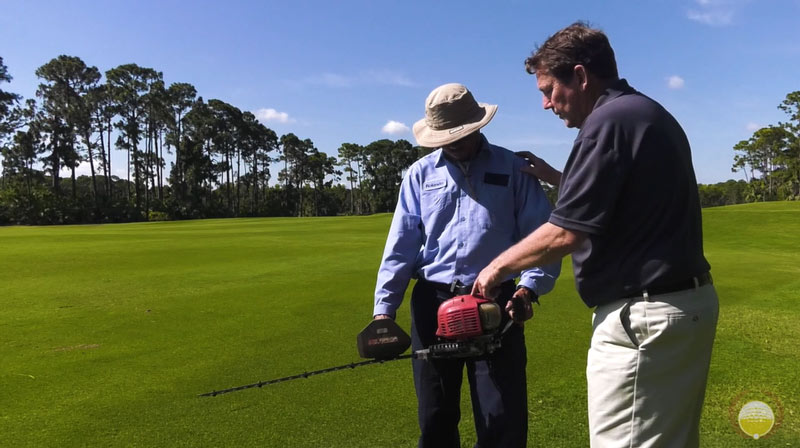
Create a working environment in which crew members feel comfortable asking their supervisors questions about equipment and training.
The Bear’s Club, in addition to having a written procedure and policy on each tool, also conducts monthly safety training sessions with staff on the subject, using Golf Safety’s training videos.
Training begins at the very top, meaning the superintendent and equipment manager with over 41 years of combined experience have trained the assistant superintendents in all the safety policies. The assistant superintendents, in turn, train the senior staff members on the crew. Those senior staff members train all the new hires or step in whenever a crew member is being trained in a new task. An important aspect of these monthly video-integrated training sessions is that they allow for demonstrations of proper PPE use and provide crew members with a space in which they can ask any questions they may have about using PPE.
PPE is the most helpful asset you’ve got when it comes to preventing injury. With small tools especially, the appropriate PPE can turn what could have been a severe injury into an absolute non-event. Before any crew member puts on PPE to use a gas power tool, they should make sure their wardrobe adheres to the following guidelines:
- Keep any long hair pulled back so it doesn’t get caught in the machinery.
- For the same reason, do not wear jewelry or loose-fitting clothing.
- Always wear long pants and sturdy boots.
Different jobs and tools require different types of PPE, so it’s essential to consult with the instruction manual or course safety plan to determine what protective equipment crew members may need. The PPE list for gas power tools generally includes safety glasses, face shields and leather gloves.
When gas power tools are loud, you should also equip your crew with hearing protection in the form of earplugs or earmuffs. You can generally tell whether a tool is loud enough to require earmuffs if the crew member using it has to raise their voice to speak to someone who is 3 feet away. If you want to create a hearing protection plan, use a dosimeter to check each piece of equipment to determine its specific noise level. You’ll get a good idea of which jobs, tools and environments require PPE that prevents hearing damage.
It’s important to remember that regular PPE maintenance and training are essential to crew safety. If your PPE is outdated or your crew doesn’t know how to use it, it won’t be effective. In this case, you might also be at risk of being fined by OSHA for not meeting its regulations.
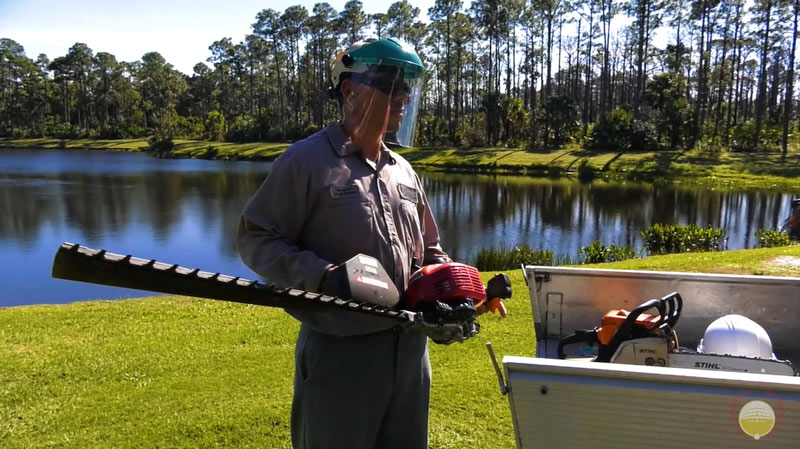
This crew member will be using a noisy hedge trimmer and chain saw — earplugs are a must.
At The Bear’s Club, after training videos but before a crew member takes out a gas power tool for the first time, his training begins in the shop. The equipment manager and his assistant check that crew member out with the machine in the shop, making sure that they have the proper PPE, they have the proper fuel cans, and checking what vehicles they’re taking into the field. The new trainee then heads out into the field with either a senior crew member or assistant superintendent, depending on the machine being used. The trainee spends time with senior staff in the field, training on the safe use of their equipment. The Bear Club limits the more dangerous equipment, such as chain saws, to the most senior crew on staff. When using dangerous equipment, the club has a rule in place that staff members should never work alone. At the end of the day, when machinery is brought back into the shop, it is cleaned and stored by the crew who were using it, and each piece is checked out by the equipment technicians to be sure it’s in good operating order for the next day. The crew is trained to report any malfunction of this equipment, especially safety-related equipment, to the equipment technicians.
In talking with Mengoli, he emphasized the fact that safety features in machinery, especially features like chain saw brakes and seat switches, are given careful inspections daily and always kept in working order. Any time a safety feature like this is malfunctioning, the machine is taken out of service and locked out so that nobody can operate it.
Mengoli tells the story of a previous club he worked at using metal safety cans that were not Type II safety cans. A crew member had set a gas can on the bumper of a piece of machinery, and it shorted out across the battery terminals. They were fortunate that the can didn’t explode and kill someone, but instead caught fire and was shooting flames out of the nozzle, like a flame thrower up in the air.
“The beauty in Type II safety cans is that it’s almost impossible for a flame to get inside of the can,” Mengoli says, “because they have a baffle inside of them that’s designed to prevent that.” He also mentioned the Bears Club uses single-gallon Type II safety cans, and the advantage of that is that they’re very low-profile, so when they’re in the back of a utility vehicle, they tend not to tip over, preventing fuel spillage. All the 1-gallon gas cans at The Bears Club are full of mixed fuel (gas and oil) to be used in two-cycle engines, and they only use one mixture. It’s helpful that the crew knows that all mixed fuel machinery comes from the same cans.
The management team at The Bear’s Club limits the amount of tree work they do in general. They don’t have an aerial lift or bucket truck on-site, nor do they allow employees to climb trees. They do this to limit liability, and they instead contract out tree work. If your club doesn’t contract tree work, it’s crucial to be extra careful around the process.
Trimming trees and hedges with gas power tools puts crew members at more risk than cutting grass or blowing leaves does. People doing these jobs have an increased chance of being struck by thrown or falling objects and encountering other dangerous environmental factors. And with the added risk of being high up, your crew must pay extra attention to the following guidelines when trimming:
- Crew members should be incredibly vigilant of cables or electric lines in the trimming area. Snagging one of these with a hedge trimmer could cause electrocution.
- Crew members must take precautions to prevent falling from the tree or tall hedge by using harnesses or ropes. They can even tie a ladder to the tree to prevent it from moving.
- Crew members should be aware of falling branches and tree limbs. These could easily injure or destabilize a crew member, causing them to fall.
- Each crew member must always wear a hard hat, safety glasses, gloves and sturdy, non-slip boots when trimming.
- If a trimming job requires climbing, ensure that you have adequately trained the crew member on height safety. Also, they should check the buckles, bolts, rivets and ropes in their climbing gear for any sign of wear or looseness before every job begins.
- Before trimming, a crew member should always inspect the area to eliminate hazardous obstacles, animals or unnecessary debris.
- Crew members must clear the area around where the maintenance is taking place and mark it out. You don’t want anyone to get hit by falling branches or flying twigs.
- This one is critical to convey to your crew: Do not cut above you. Branches may fall unpredictably and could cause severe injury if you are in their path.
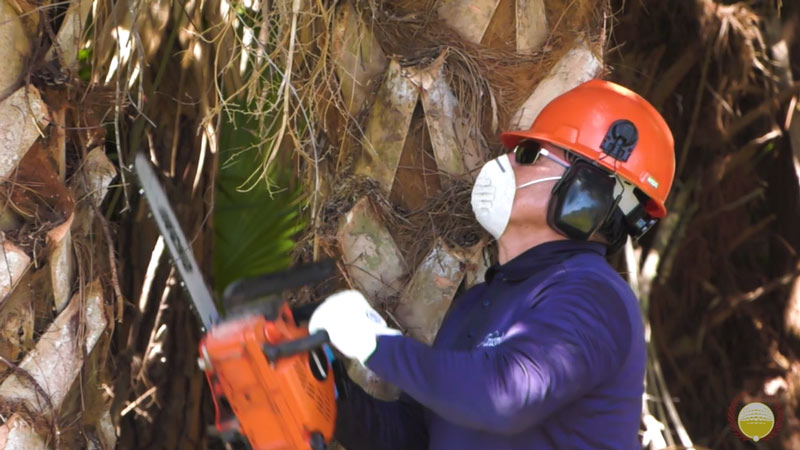
Notice how this crew member is raising his tool to cut branches an arm’s length away from him, not directly above his head.
Mengoli and Katterheinrich believe there’s no point in adding safety policies and procedures or PPE and equipment guidelines if you’re not going to enforce them. At The Bear’s Club, the policies are enforced by the assistant superintendents who are supervising. When considering how to enforce these guidelines on your golf course, there are three main factors to keep in mind when it comes to gas power tools:
- Your crew must be adequately trained to use their gas power tools to put their safety first.
- If well maintained and worn correctly, PPE can lessen the severity of an injury or prevent it from happening entirely.
- Specific jobs in which crew members use gas tools, such as hedge and tree trimming, require more vigilance and training than more simple tasks do.
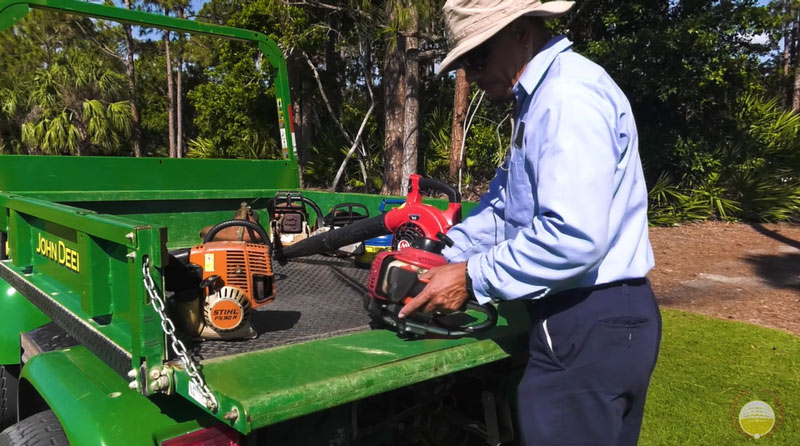
Remember: Although training takes time initially, it will save you time in the long run through greater crew efficiency and fewer safety incidents.
Would you like more specific advice on keeping your crew safe when dealing with gas power tools? Or are you interested in having a Golf Safety representative visit your facility to create a custom safety plan for you? If the answer is yes, schedule a demo call with Golf Safety.